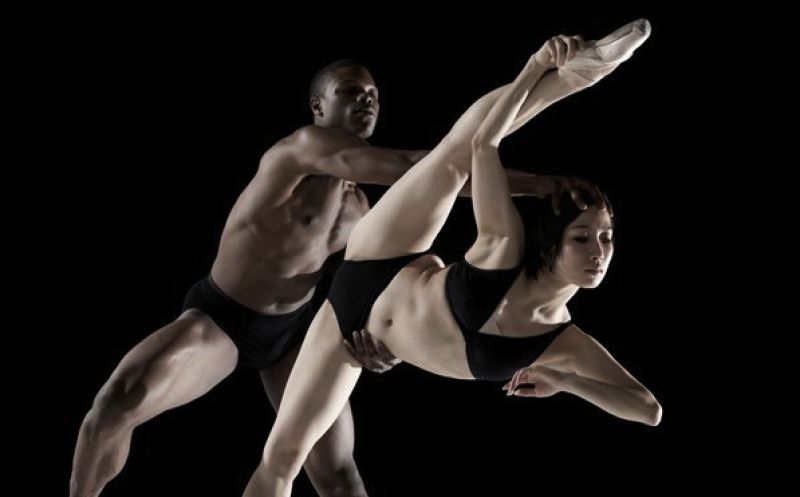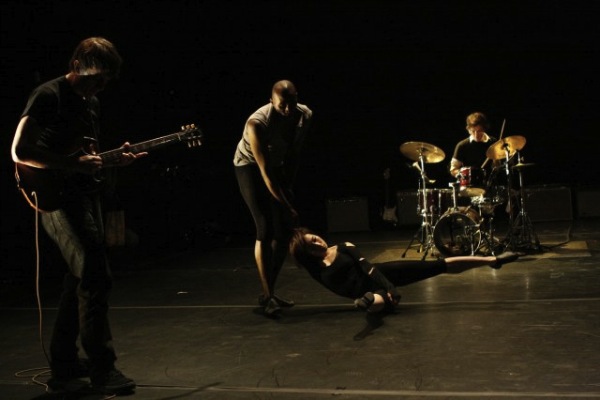Armitage Gone! Dance, Queen Elizabeth Hall | reviews, news & interviews
Armitage Gone! Dance, Queen Elizabeth Hall
Armitage Gone! Dance, Queen Elizabeth Hall
A youthful reputation as a punk ballet-maker is hard to match up to 30 years on

I wasn’t around to see when Karole Armitage won her spurs in her twenties as a punk ballet choreographer in America in the 1970s and early Eighties, so we must rely on her programme-sheet biography to explain to us that she is “seen by some critics as the true choreographic heir" to George Balanchine and Merce Cunningham. After last night’s dismal showing by her group, Armitage Gone!
It had started badly with Armitage stepping up in a sparse Queen Elizabeth Hall to lecture us on quantum mechanics, Einstein’s relativity theory and string theory, in a garrulous, blurry way that ended with her saying kindly, “This is all a way to, you know, think about reality.” She added that there would be a Q&A at the end “when you’ll be able to talk to me”. For a nano-second you could hear the audience's breath being held and released, as eyes rolled in polite British disbelief.
To business, then, with the two offerings: a new creation called Two Theories, allegedly illustrating the bittiness of quantum mechanics followed by the glueyness of string theory, and Drastic-Classicism, the 1981 work that made Armitage's reputation, which with its Goth ripped clothing and aggressive attitude is at least a vital souvenir of its time.
These are leftovers of Eighties William Forsythe and Michael Clark reheated in the intellectual microwave of today’s science buzzwords
Both have crashing, slashing scores by the renowned punk guitarist of the Seventies, Rhys Chatham; both turned to ear-splitting decibels. But even aural disorientation could not fully muddle me into thinking Two Theories was anything other than a job lot of six-packed gym bunnies trained to do little more than smack their legs into spatchcock splits and flare their hands, leftover mannerisms of Eighties William Forsythe and Michael Clark reheated in the intellectual microwave of today’s science buzzwords.
Frankly it was a waste of time watching such inexpert dancers in work that seems to want to continue to make some sort of social stand about ballet tradition. Would it not be more subversive if they had stretched feet, controlled legs, alert torsos, poised backs, receptive shoulders, quick eyes, refined lines, all the weaponry of ballet that they could then switch, with more devastating effect, to protest mode?
But the women’s feet wore pointe shoes with as little interest as if they were stilts, the men were a flabby set of movers, and I have a prejudice against choreographers who give dancers a lot of balancing on one leg to do and then don’t train the dancers not to wobble about like ropes in a typhoon. Edouard Lock’s La La La Human Steps were miracles of articulation and bravura next to this lot.
 Drastic-Classicism saw the thin audience dwindle further, possibly causing a late-night rush to neuro-otology departments because four guitarists and a drum kit made an even more torturously loud din than you imagined possible from the previous piece. Extraordinary how orchestras are banned from playing Tchaikovsky’s Sleeping Beauty without sound protection when dance theatres from Rosebery Avenue to Belvedere Road are busy dismantling the audience’s hearing with their wicked boy's-own sound systems and crepuscular lighting, as if all a dance fan needed was big eyes and no eardrums.
Drastic-Classicism saw the thin audience dwindle further, possibly causing a late-night rush to neuro-otology departments because four guitarists and a drum kit made an even more torturously loud din than you imagined possible from the previous piece. Extraordinary how orchestras are banned from playing Tchaikovsky’s Sleeping Beauty without sound protection when dance theatres from Rosebery Avenue to Belvedere Road are busy dismantling the audience’s hearing with their wicked boy's-own sound systems and crepuscular lighting, as if all a dance fan needed was big eyes and no eardrums.
The piece has Eighties smarts - it slams violent punky females in pointe shoes into a slamdunk jam session with hard rock’s sullen male guitarists and drummers. The girls interfere persistently with the boys’ instruments, like groupies demanding a fix, refusing to behave and mockingly spreading their legs. They form secret phalanxes at the back in the dark and charge on the audience. Barriers are toppled between dancers and musicians, between performers and audience. The fact that the work used balletic tropes this way, in an age of old men’s ballet (Balanchine, Cunningham and Ashton were all venerable by then), seems a good, brutal ladette joke, and Armitage's hard-nosed reputation got her commissions for pop video choreography from Madonna and Michael Jackson.
Time marches on, disapprovingly. A quarter-century later, X Factor routines and Beyoncé videos look much like Armitage's signature piece, and today's ladettes make her stroppy gals look like attention-deficient Brownies. All in all, a drastically uninspiring evening.
- Armitage Gone! Dance performs again tonight at the Queen Elizabeth Hall, London, as part of Dance Umbrella 2011
Share this article
Add comment
The future of Arts Journalism
You can stop theartsdesk.com closing!
We urgently need financing to survive. Our fundraising drive has thus far raised £49,000 but we need to reach £100,000 or we will be forced to close. Please contribute here: https://gofund.me/c3f6033d
And if you can forward this information to anyone who might assist, we’d be grateful.

Subscribe to theartsdesk.com
Thank you for continuing to read our work on theartsdesk.com. For unlimited access to every article in its entirety, including our archive of more than 15,000 pieces, we're asking for £5 per month or £40 per year. We feel it's a very good deal, and hope you do too.
To take a subscription now simply click here.
And if you're looking for that extra gift for a friend or family member, why not treat them to a theartsdesk.com gift subscription?
more Dance
 'We are bowled over!' Thank you for your messages of love and support
Much-appreciated words of commendation from readers and the cultural community
'We are bowled over!' Thank you for your messages of love and support
Much-appreciated words of commendation from readers and the cultural community
 R:Evolution, English National Ballet, Sadler's Wells review - a vibrant survey of ballet in four acts
ENB set the bar high with this mixed bill, but they meet its challenges thrillingly
R:Evolution, English National Ballet, Sadler's Wells review - a vibrant survey of ballet in four acts
ENB set the bar high with this mixed bill, but they meet its challenges thrillingly
 Like Water for Chocolate, Royal Ballet review - splendid dancing and sets, but there's too much plot
Christopher Wheeldon's version looks great but is too muddling to connect with fully
Like Water for Chocolate, Royal Ballet review - splendid dancing and sets, but there's too much plot
Christopher Wheeldon's version looks great but is too muddling to connect with fully
 iD-Reloaded, Cirque Éloize, Marlowe Theatre, Canterbury review - attitude, energy and invention
A riotous blend of urban dance music, hip hop and contemporary circus
iD-Reloaded, Cirque Éloize, Marlowe Theatre, Canterbury review - attitude, energy and invention
A riotous blend of urban dance music, hip hop and contemporary circus
 How to be a Dancer in 72,000 Easy Lessons, Teaċ Daṁsa review - a riveting account of a life in dance
Michael Keegan-Dolan's unique hybrid of physical theatre and comic monologue
How to be a Dancer in 72,000 Easy Lessons, Teaċ Daṁsa review - a riveting account of a life in dance
Michael Keegan-Dolan's unique hybrid of physical theatre and comic monologue
 A Single Man, Linbury Theatre review - an anatomy of melancholy, with breaks in the clouds
Ed Watson and Jonathan Goddard are extraordinary in Jonathan Watkins' dance theatre adaptation of Isherwood's novel
A Single Man, Linbury Theatre review - an anatomy of melancholy, with breaks in the clouds
Ed Watson and Jonathan Goddard are extraordinary in Jonathan Watkins' dance theatre adaptation of Isherwood's novel
 Peaky Blinders: The Redemption of Thomas Shelby, Rambert, Sadler's Wells review - exciting dancing, if you can see it
Six TV series reduced to 100 minutes' dance time doesn't quite compute
Peaky Blinders: The Redemption of Thomas Shelby, Rambert, Sadler's Wells review - exciting dancing, if you can see it
Six TV series reduced to 100 minutes' dance time doesn't quite compute
 Giselle, National Ballet of Japan review - return of a classic, refreshed and impeccably danced
First visit by Miyako Yoshida's company leaves you wanting more
Giselle, National Ballet of Japan review - return of a classic, refreshed and impeccably danced
First visit by Miyako Yoshida's company leaves you wanting more
 Quadrophenia, Sadler's Wells review - missed opportunity to give new stage life to a Who classic
The brilliant cast need a tighter score and a stronger narrative
Quadrophenia, Sadler's Wells review - missed opportunity to give new stage life to a Who classic
The brilliant cast need a tighter score and a stronger narrative
 The Midnight Bell, Sadler's Wells review - a first reprise for one of Matthew Bourne's most compelling shows to date
The after-hours lives of the sad and lonely are drawn with compassion, originality and skill
The Midnight Bell, Sadler's Wells review - a first reprise for one of Matthew Bourne's most compelling shows to date
The after-hours lives of the sad and lonely are drawn with compassion, originality and skill
 Ballet to Broadway: Wheeldon Works, Royal Ballet review - the impressive range and reach of Christopher Wheeldon's craft
The title says it: as dancemaker, as creative magnet, the man clearly works his socks off
Ballet to Broadway: Wheeldon Works, Royal Ballet review - the impressive range and reach of Christopher Wheeldon's craft
The title says it: as dancemaker, as creative magnet, the man clearly works his socks off
 The Forsythe Programme, English National Ballet review - brains, beauty and bravura
Once again the veteran choreographer and maverick William Forsythe raises ENB's game
The Forsythe Programme, English National Ballet review - brains, beauty and bravura
Once again the veteran choreographer and maverick William Forsythe raises ENB's game

Comments
Super harsh "review"... more